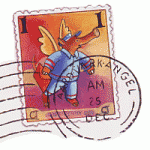Teri Sloat remembers being painfully shy. Books were her escape. She physically shielded herself with them so she wouldn’t be required to converse with people, but she also found salvation in them. Through books she found kindred spirits who were shy and didn’t fit in. “Every night at 7:30 my mother would read to me,” Sloat says. Kids in her Oregon neighborhood joined the story times because their own parents didn’t read to them. “After the stories the kids would go home and I would go to bed.” She remembers thinking she was lucky she owned so many books and only later learned that most of them came from the library. “When we moved [my mother] out of her house at age 89, she was still reading to the last little boy in the neighborhood.”
A local artist whom Sloat visited for art lessons was another influential person in her life. “I remember the smell of turpentine and paint,” says Sloat. “I felt like I’d died and gone to heaven when I entered her studio.” Now Sloat wonders if her eleven year old art pupil has the same feelings about her.
From an early age Sloat thought in stories. She tapped out stories on her mother’s typewriter and reveled in the idea that she could create new worlds with words and pictures. Her talent for storytelling was honed in Alaska where Sloat and her husband moved to teach. They lived at the mouth of the Yukon, north of the Arctic Circle. Although her students had only a rudimentary grasp of English, they responded to picture books that were lyrical. Sloat wondered how authors created a fluid story line that was easy to listen to even for non-English speakers and started experimenting by writing folk tales about the people and customs she observed on the tundra.
Sloat also illustrated books produced by the Bilingual Center in Bethel, Alaska. She and six other teachers combined their talents and produced 250 books in six years in both English and Yup’ik, the Native language spoken in that part of the state. But the experience of writing, illustrating, translating, printing, and collating books was not enough for Sloat. She wondered, “How do we move to producing what’s on the library shelves?”
The answer to that question did not present itself until Sloat and her husband moved from Alaska to Sebastopol, California. A friend asked Sloat to create some sketches for a manuscript she planned to submit to her agent. Unfortunately for Sloat’s friend, the manuscript didn’t sell, but the agent asked Sloat if she was interested in children’s book illustration. “I was so afraid [the dream] wasn’t going to come true that I put it aside for six months,” says Sloat. When she finally worked up the courage to send the agent From Letter to Letter, it sold to Dutton almost immediately and earned a place on the New York Times Best Books of the Year list.
Ideas from everyday life insert themselves into Sloat’s books. “My husband is Farmer Brown,” she says. The seed for The Thing That Bothered Farmer Brown was planted on a camping trip when a mosquito buzzed around their cabin annoying her husband. When she and her husband went to Guam for a school visit, she says, “the kids were more excited to meet Farmer Brown than me!” The three Farmer Brown books are illustrated by Nadine Bernard Westcott because Sloat realizes that her own artistic style does not always match the story she’s trying to tell.
The cocky, self-assured duck in I’m a Duck presented himself to Sloat while she was waiting for a bus. The duck won her admiration because he strutted back and forth with “a confidence that I didn’t have when I was younger,” she says.
Through Anana in Berry Magic, Sloat explored the idea of women wielding power. “If there was magic [in Alaskan folklore],” she says, “it was always by a male shaman.” So she created a younger version of Tomie dePaola’s Strega Nona, one of her favorite literary characters.
Sloat’s latest idea was fraught with challenges. Her instincts told her she had a good story, but she wasn’t able to tell it. “Sometimes I feel I’ve tried to write something before I’m ready. The idea’s there. The story line’s there. Then five years later something will happen in my life…The right voice will come or a better reason for writing [the story].” The catalyst for her current project was her nephew, a film director, who offered to help her animate the story. Her nephew’s guidance helped her think about the story on a basic level—the movements of her characters and how the action develops from scene to scene—thereby helping her to define her plot and characters.
Throughout Sloat’s prolific career she has been willing to learn more about the craft of writing and the discipline one must have to succeed as a professional artist. Even though certain projects are more difficult than others, she has the perseverance to stick with them because she follows her passion rather than what the market or her editor may expect.


